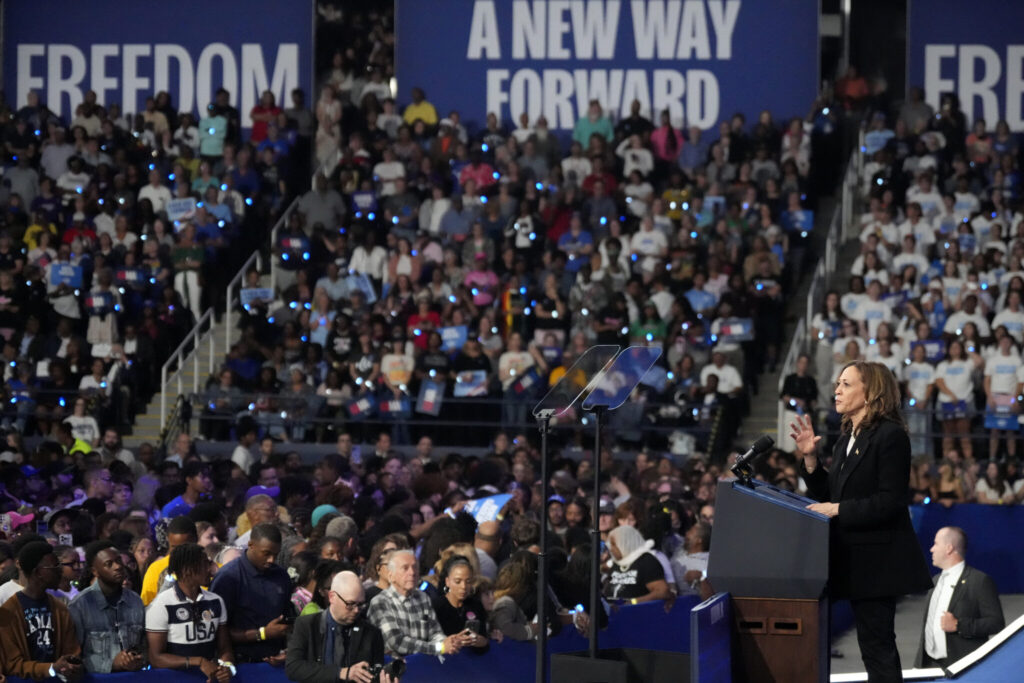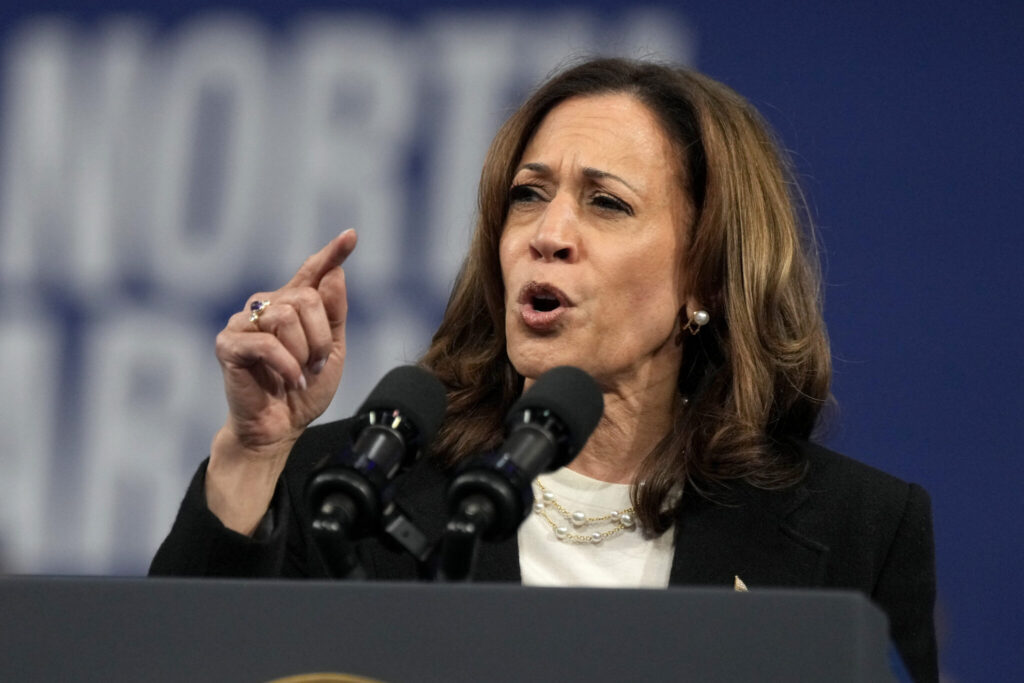Battleground states 2024 election/ Harris Republican endorsements/ Trump campaign rhetoric/ Newslooks/ CHARLOTTE/ N.C./ Vice President Kamala Harris and Donald Trump hit key swing states with contrasting strategies: Harris touted Republican endorsements and emphasized healthcare and abortion rights, while Trump leaned into fiery rhetoric, targeting immigration and criticizing Harris. Their campaigns highlight two starkly different approaches for the 2024 election.

Harris Courts GOP, Trump Ramps Up Attacks – Quick Looks
- Kamala Harris campaigns in North Carolina, highlighting Republican endorsements and focusing on healthcare and abortion rights.
- Donald Trump campaigns in Arizona, promising tax breaks and using incendiary rhetoric on immigration and his political opponents.
- Harris emphasized bipartisan support, celebrating endorsements from Dick and Liz Cheney, who have rejected Trump’s leadership.
- Trump criticized Harris, rehashing past attacks on immigration and presenting a grim picture of America under Biden and Harris.
- Trump promised to cut housing costs and taxes on overtime wages, while Harris framed him as lacking concrete policy plans.
- Both candidates focused on battleground states that will be key to winning the 2024 election.
Harris Gains Republican Endorsements, Trump Ramps Up Attacks
Deep Look
Vice President Kamala Harris and former President Donald Trump took to the campaign trail Thursday, each setting their sights on critical swing states that could determine the outcome of the 2024 presidential election. With strikingly different tones and strategies, both candidates aimed to sway voters in their favor as they moved closer to the election.
In North Carolina, Harris used her rallies in Charlotte and Greensboro to celebrate Republican endorsements and underscore her commitment to protecting healthcare and abortion rights. As the Democratic nominee, Harris has positioned herself as a unifier, attempting to draw support from a broad coalition of voters. She highlighted endorsements from prominent Republicans, including former Vice President Dick Cheney and his daughter, ex-Rep. Liz Cheney, both of whom have labeled Trump a threat to American democracy.
Speaking to a cheering crowd, Harris framed her campaign as one focused on preserving constitutional values. “Democrats, Republicans, and independents are supporting our campaign,” she said, referencing the Cheneys’ support. “We are putting country above party.” Harris also revisited key points from her debate against Trump earlier in the week, where she hammered him on issues like healthcare. She mocked Trump for lacking a concrete replacement for the Affordable Care Act, sarcastically pointing out his vague reference to “concepts” during their debate.
Her campaign messaging has stayed consistent, focusing on key issues that resonate with her party’s base while also attempting to court moderate Republicans. Harris also reiterated her commitment to protecting women’s healthcare, reminding voters that Trump’s Supreme Court picks were responsible for overturning Roe v. Wade. “Women are being refused care during miscarriages,” she said, emphasizing the real-world consequences of the court’s decision and Republican-led state restrictions on abortion.
Meanwhile, in Arizona, Trump delivered a fiery speech that leaned heavily into his usual rhetoric on immigration, law and order, and his disdain for political opponents. Speaking to a raucous crowd in Tucson, Trump unveiled a new campaign proposal to exempt overtime wages from taxation, adding it to his previous pledges to eliminate taxes on tips and Social Security income. Yet, while he introduced these policy ideas, the majority of his 75-minute speech focused on sharply criticizing Harris, repeating claims about immigration, and painting a dire picture of the nation’s future under the current administration.
Trump’s rhetoric became particularly heated when discussing immigration. He reiterated his claims about migrants “taking over” U.S. cities and suburbs, referencing discredited rumors that have circulated online. He promised his supporters that he would launch “the largest deportation operation in the history of our country,” drawing loud cheers from the audience. Trump also attacked Harris personally, mispronouncing her name multiple times and labeling her both a Marxist and a fascist—despite these ideologies being on opposite sides of the political spectrum.
While Trump did introduce new policy proposals, such as reducing housing construction costs, he offered few specifics on how he would accomplish these ambitious goals. His speech largely focused on rallying his core supporters by tapping into grievances and fears about immigration and national security. The contrast with Harris’ approach was stark, as Trump doubled down on his base-oriented strategy, betting that his most loyal supporters, along with some working-class voters, will carry him to victory.
The 2024 election campaign has centered around a handful of battleground states, with Arizona and North Carolina among the most fiercely contested. Harris reminded her North Carolina crowd of the stakes, cautioning them against complacency. “This is not 2016 or 2020,” she said, urging voters to imagine a Trump presidency “with no guardrails.”
Harris’ strategy involves exciting the Democratic base—particularly younger voters, nonwhite voters, and women—while also appealing to moderate Republicans who may feel alienated by Trump’s aggressive approach. This broad coalition was key to Biden’s victory in 2020, helping him flip traditionally Republican states like Arizona and Georgia.
Trump, on the other hand, has made it clear that he is sticking with the strategy that propelled him to victory in 2016. His appeal to blue-collar and working-class voters, along with his promises of tax breaks, aims to build on his loyal base while attempting to win over new supporters with populist economic ideas. His rhetoric, however, continues to focus heavily on stoking fear about immigration and painting the country’s future in stark, alarming terms under Democratic leadership.
As both candidates move closer to the election, their competing visions highlight the fundamental choices voters in these key swing states will have to make. Harris, with her emphasis on unity and bipartisan support, is betting that a broad, diverse coalition will carry her to victory, while Trump continues to double down on fiery, base-driven rhetoric aimed at his most ardent supporters.







